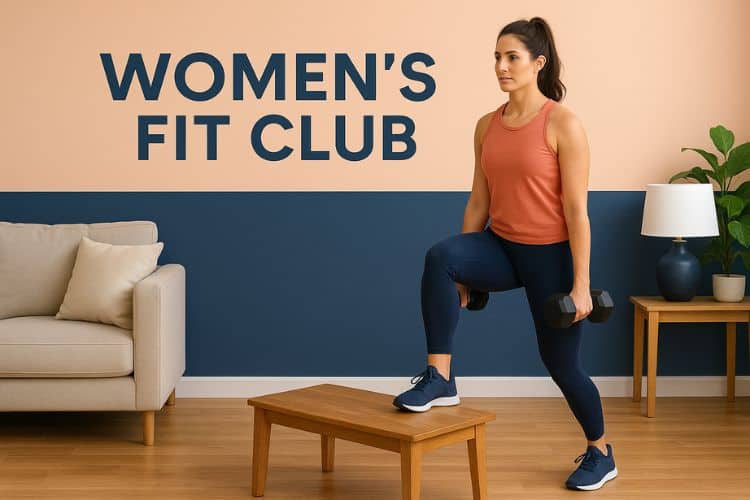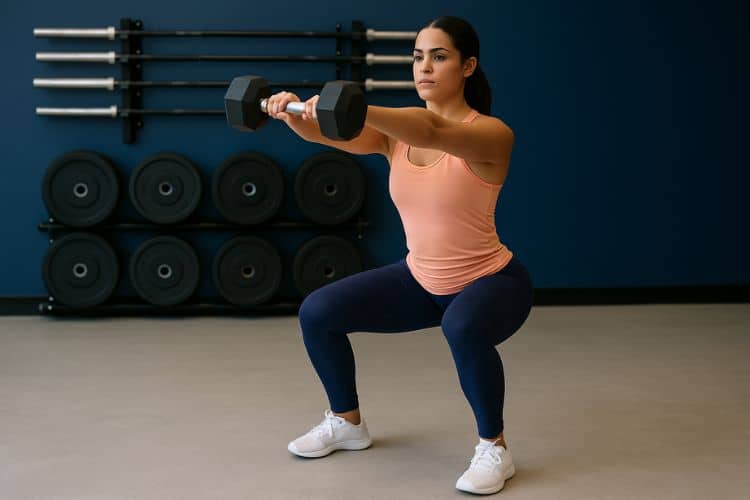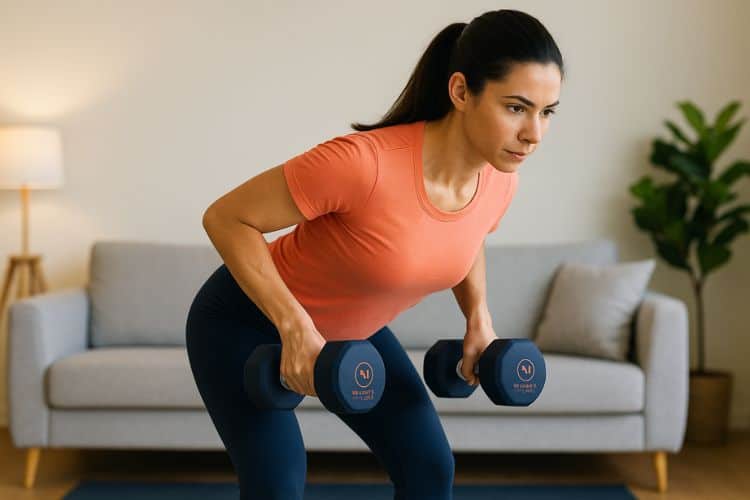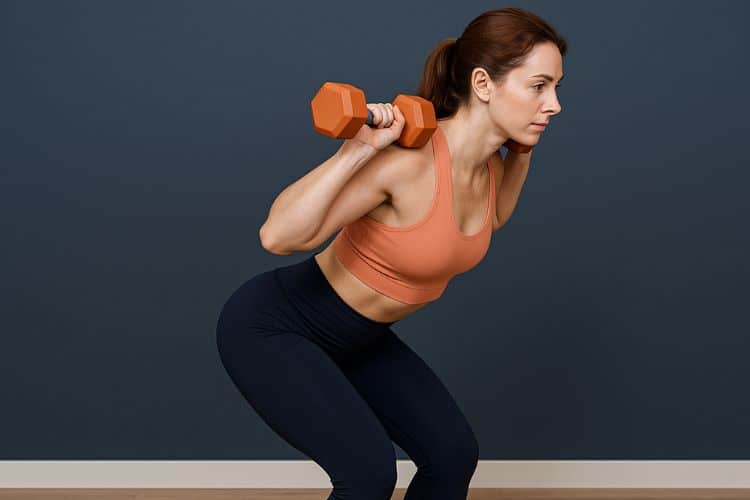Sign up for workout ideas, training advice, reviews of the latest gear and more.





Building a strong posterior chain — your hamstrings, glutes, and lower back — is essential for better posture, athletic performance, and injury prevention. One of the most effective yet underrated movements to develop these areas is the good mornings exercise. Traditionally performed with a barbell, the dumbbell good morning is a versatile variation perfect for home workouts or lighter resistance training.
In this article, you’ll learn everything about performing good mornings with dumbbells safely and effectively, including proper form, benefits, variations, and tips to integrate this move into your workout plan.
The dumbbell good morning is a hinge-based strength exercise that primarily targets the hamstrings, glutes, and lower back. It gets its name from the movement pattern — when you bow forward at the hips, it resembles the motion of saying “good morning.”
Unlike barbell versions that rest on your upper back, the dumbbell version allows more flexibility and control. You can hold dumbbells in various positions (by your sides, across your shoulders, or at chest height) to modify intensity and comfort.
The good morning with dumbbells is a compound movement that recruits several key muscle groups across the posterior chain:
This combination makes the exercise a foundational movement for building strength, balance, and coordination.
Incorporating good mornings with dumbbells into your training offers multiple fitness benefits beyond aesthetics.
Most people overtrain the front of the body (quads and chest) and neglect the back. Dumbbell good mornings correct this imbalance by activating the hamstrings, glutes, and lower back, leading to better posture and performance.
The hip hinge is a crucial movement pattern used in deadlifts, squats, and kettlebell swings. Practicing dumbbell good mornings reinforces this motion, helping you learn to move through the hips instead of the spine — a critical skill for injury prevention.
A strong posterior chain is essential for running, jumping, and lifting. Athletes who regularly perform good mornings often notice improvements in acceleration, vertical jump height, and sprint speed.
Holding the dumbbells while hinging forward engages the deep abdominal muscles, improving stability and reducing the risk of lower back strain.
Unlike barbell exercises, dumbbell good mornings don’t require a rack or large space. You can do them anywhere, making them an ideal choice for home strength training.
Proper form is crucial to maximize effectiveness and minimize injury risk. Follow this step-by-step guide to master the movement.
Before hinging forward, brace your core, slightly bend your knees, and keep your spine neutral. Avoid arching or rounding your back.
You’ll feel a deep stretch in your hamstrings at the bottom. Pause briefly for one second while keeping tension on your glutes and hamstrings.
Drive your hips forward and squeeze your glutes as you return to the starting position. Keep your movements slow and controlled.
Even though the good morning exercise looks simple, many people perform it incorrectly. Avoid these common errors to ensure proper technique:
One of the biggest mistakes is rounding the spine during the hinge. Always maintain a neutral back by keeping your chest up and shoulders back.
The good morning is not a squat. A slight knee bend is fine, but too much turns it into a different exercise. Keep the focus on your hips moving backward.
Start with light dumbbells to learn proper form before increasing weight. Overloading too early can lead to hamstring pulls or back injuries.
Failing to brace the core reduces stability and puts extra pressure on your spine. Tighten your abs throughout every rep.
The good morning is a controlled, slow exercise. Focus on muscle activation rather than speed or momentum.
Once you master the standard version, try these variations to target your muscles from different angles and add variety to your workouts.
Sit on a bench with feet flat and dumbbells across your shoulders. Hinge forward and return upright. This version isolates the lower back and hamstrings with minimal knee involvement.
Hold one dumbbell in the opposite hand of your working leg. Extend the non-working leg behind you as you hinge forward. This improves balance, core control, and unilateral strength.
Hold the dumbbells against your chest. This shifts the center of gravity forward and adds more core engagement, making it a great variation for stability.
Perform the exercise with your feet wider than shoulder-width. This increases the stretch and focuses more on the inner hamstrings and adductors.
Add a resistance band around your hips anchored behind you. This increases tension during the hip extension, enhancing glute activation.
Both variations strengthen the posterior chain, but they have distinct differences:
| Feature | Dumbbell Good Morning | Barbell Good Morning |
|---|---|---|
| Equipment | Dumbbells (versatile and accessible) | Requires barbell and rack |
| Difficulty | Easier to control | Requires more balance |
| Spinal Load | Lighter and safer for beginners | Heavier load on lower back |
| Range of Motion | Greater flexibility | Limited by bar position |
| Ideal For | Home workouts and beginners | Advanced lifters |
If you’re new to the movement or training at home, the dumbbell variation is your best starting point.
The dumbbell good morning fits well into strength, hypertrophy, and functional training programs. Here’s how to include it strategically.
Perform 2–3 sets of 12–15 reps using light dumbbells to activate your hamstrings and glutes before doing heavier lifts like deadlifts or squats.
Include dumbbell good mornings as part of a leg day routine to strengthen your backside muscles. Example circuit:
Combine this exercise with compound movements to build balanced strength:
If you’re a powerlifter or strength athlete, the dumbbell good morning helps improve lockout strength and hip drive during deadlifts.
While the dumbbell good morning is safe when performed correctly, it can strain the lower back if done improperly. Keep these tips in mind:
Though they look similar, these two hinge-based exercises have unique mechanics:
| Feature | Dumbbell Good Morning | Dumbbell Romanian Deadlift |
|---|---|---|
| Weight Position | On shoulders or chest | Hanging in front of thighs |
| Range of Motion | Torso leans forward | Dumbbells lower toward shins |
| Primary Focus | Lower back and hamstrings | Hamstrings and glutes |
| Core Engagement | Higher due to load placement | Moderate |
| Learning Curve | Easier for beginners | Requires more coordination |
Both exercises complement each other — combining them enhances overall lower body strength and control.
Yes! Start with light dumbbells or even no weight at first. Focus on learning the hip hinge pattern and maintaining a neutral spine.
Beginners should start with 5–10 lb dumbbells and gradually increase as form improves. The goal is to feel tension in the hamstrings, not strain in the back.
It’s best to give your posterior chain 48 hours of rest between sessions to allow proper recovery.
If you don’t have dumbbells, you can substitute with:
You’ll feel mild engagement in your lower back, but the main tension should be in your hamstrings and glutes. If your lower back feels strained, check your form.
The dumbbell good morning exercise is one of the most efficient movements for building lower body strength, stability, and flexibility. Its simplicity and adaptability make it ideal for home workouts or gym routines. Whether you’re a beginner or an advanced lifter, incorporating this exercise will improve your posterior chain strength, hip hinge mechanics, and core stability — all of which translate into better athletic performance and injury resilience.
To get started, practice the movement slowly, prioritize proper form, and increase resistance over time. Combined with other compound lifts like deadlifts, squats, and hip thrusts, the dumbbell good morning will become one of your most valuable exercises for long-term strength and balance.
At Women’s Fit Club, we’re all about giving you tools for real, sustainable progress. If you enjoyed this Dumbbell Good Mornings Exercise, you might also like our 30-minute kettlebell HIIT workout, 30-minute full body home workout, or 35-minute dumbbell HIIT workout for more varied training options. Be sure to check out our nutrition guides such as progressive overload glute workout, and explore our Weight Loss Journey Guide for Women for tips to help you maximize results over time.
Stay up to date on the latest women’s health, fitness and lifestyle trends and tips.